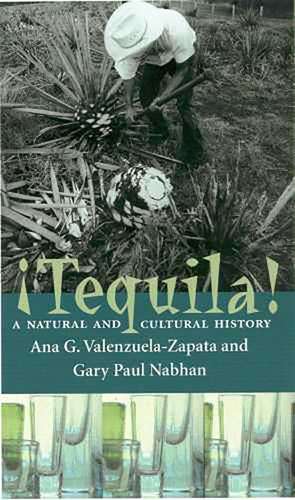Tequila: A Natural and Cultural History
Autor Ana G. Valenzuela-Zapata, Gary Paul Nabhanen Limba Engleză Paperback – mar 2004
The array of bottles is impressive, their contents finely tuned to varied tastes. But they all share the same roots in Mesoamerica's natural bounty and human culture.
The drink is tequila—more properly, mescal de tequila, the first mescal to be codified and recognized by its geographic origin and the only one known internationally by that name. In ¡Tequila! A Natural and Cultural History, Ana G. Valenzuela-Zapata, the leading agronomist in Mexico's tequila industry, and Gary Paul Nabhan, one of America's most respected ethnobotanists, plumb the myth of tequila as they introduce the natural history, economics, and cultural significance of the plants cultivated for its production.
Valenzuela-Zapata and Nabhan take you into the agave fields of Mexico to convey their passion for the century plant and its popular by-product. In the labor-intensive business of producing quality mescal, the cultivation of tequila azul is maintained through traditional techniques passed down over generations. They tell how jimadores seek out the mature agaves, strip the leaves, and remove the heavy heads from the field; then they reveal how the roasting and fermentation process brings out the flavors that cosmopolitan palates crave.
Today in Oaxaca it's not unusual to find small-scale mescal-makers vending their wares in the market plaza, while in Jalisco the scale of distillation facilities found near the town of Tequila would be unrecognizable to old José Cuervo. Valenzuela-Zapata and Nabhan trace tequila's progress from its modest beginnings to one of the world's favored spirits, tell how innovations from cross-cultural exchanges made fortunes for Cuervo and other distillers, and explain how the meteoric rise in tequila prices is due to an epidemic—one they predicted would occur—linked to the industry's cultivation of just one type of agave.
The tequila industry today markets more than four hundred distinct products through a variety of strategies that heighten the liquor's mystique, and this book will educate readers about the grades of tequila, from blanco to añejo, and marks of distinction for connoisseurs who pay up to two thousand dollars for a bottle. ¡Tequila! A Natural and Cultural History will feed anyone's passion for the gift of the blue agave as it heightens their appreciation for its rich heritage.
The drink is tequila—more properly, mescal de tequila, the first mescal to be codified and recognized by its geographic origin and the only one known internationally by that name. In ¡Tequila! A Natural and Cultural History, Ana G. Valenzuela-Zapata, the leading agronomist in Mexico's tequila industry, and Gary Paul Nabhan, one of America's most respected ethnobotanists, plumb the myth of tequila as they introduce the natural history, economics, and cultural significance of the plants cultivated for its production.
Valenzuela-Zapata and Nabhan take you into the agave fields of Mexico to convey their passion for the century plant and its popular by-product. In the labor-intensive business of producing quality mescal, the cultivation of tequila azul is maintained through traditional techniques passed down over generations. They tell how jimadores seek out the mature agaves, strip the leaves, and remove the heavy heads from the field; then they reveal how the roasting and fermentation process brings out the flavors that cosmopolitan palates crave.
Today in Oaxaca it's not unusual to find small-scale mescal-makers vending their wares in the market plaza, while in Jalisco the scale of distillation facilities found near the town of Tequila would be unrecognizable to old José Cuervo. Valenzuela-Zapata and Nabhan trace tequila's progress from its modest beginnings to one of the world's favored spirits, tell how innovations from cross-cultural exchanges made fortunes for Cuervo and other distillers, and explain how the meteoric rise in tequila prices is due to an epidemic—one they predicted would occur—linked to the industry's cultivation of just one type of agave.
The tequila industry today markets more than four hundred distinct products through a variety of strategies that heighten the liquor's mystique, and this book will educate readers about the grades of tequila, from blanco to añejo, and marks of distinction for connoisseurs who pay up to two thousand dollars for a bottle. ¡Tequila! A Natural and Cultural History will feed anyone's passion for the gift of the blue agave as it heightens their appreciation for its rich heritage.
Preț: 100.20 lei
Nou
Puncte Express: 150
Preț estimativ în valută:
19.17€ • 20.02$ • 15.83£
19.17€ • 20.02$ • 15.83£
Carte disponibilă
Livrare economică 25 martie-08 aprilie
Preluare comenzi: 021 569.72.76
Specificații
ISBN-13: 9780816519385
ISBN-10: 0816519382
Pagini: 113
Dimensiuni: 140 x 235 x 15 mm
Greutate: 0.23 kg
Ediția:New.
Editura: University of Arizona Press
Colecția University of Arizona Press
ISBN-10: 0816519382
Pagini: 113
Dimensiuni: 140 x 235 x 15 mm
Greutate: 0.23 kg
Ediția:New.
Editura: University of Arizona Press
Colecția University of Arizona Press
Notă biografică
Ana Guadalupe Valenzuela-Zapata is recognized in Mexico and the United States as the foremost botanical and horticultural expert on agaves used in the tequila industry. A professor at the Universidad de Guadalajara, and one of the few women field scientists in a male-dominated industry, she is author of the Spanish language book, El Agave Tequilero, and numerous scientific articles on the blue agave.
A MacArthur Fellow and recipient of a Lifetime Achievement Award from the Society for Conservation Biology, Gary Paul Nabhan is Director of the Center for Sustainable Environments at Northern Arizona University.
A MacArthur Fellow and recipient of a Lifetime Achievement Award from the Society for Conservation Biology, Gary Paul Nabhan is Director of the Center for Sustainable Environments at Northern Arizona University.
Recenzii
"No mere barroom reference, this heady blend of agricultural history, Mescalero anthropology, Aztec mythology and nature writing is an appealing package for researchers and drinkers alike." —Publishers Weekly
"A richly textured picture of tequila and the agave plant . . . Readers interested in the natural history and ethnography of the Southwest will enjoy it, as will tequila fanciers who want to learn about the history and manufacture of their drink." —San Diego Union-Tribune
"Lyricism for all things agave infuses the prose, a rhapsody tempered by hard botanical science." —San Francisco Chronicle
"A scholarly yet entertaining guide to the history and husbandry of this phenomenal beverage . . . For most readers, tequila may be better sipped than studied. But since a little tequila goes a long way, this book can provide an alternate, albeit less intoxicating, form of pleasure." —Natural History
"This slender tome contains virtually everything you could want to know about tequila." —New Mexico Magazine
"A richly textured picture of tequila and the agave plant . . . Readers interested in the natural history and ethnography of the Southwest will enjoy it, as will tequila fanciers who want to learn about the history and manufacture of their drink." —San Diego Union-Tribune
"Lyricism for all things agave infuses the prose, a rhapsody tempered by hard botanical science." —San Francisco Chronicle
"A scholarly yet entertaining guide to the history and husbandry of this phenomenal beverage . . . For most readers, tequila may be better sipped than studied. But since a little tequila goes a long way, this book can provide an alternate, albeit less intoxicating, form of pleasure." —Natural History
"This slender tome contains virtually everything you could want to know about tequila." —New Mexico Magazine







